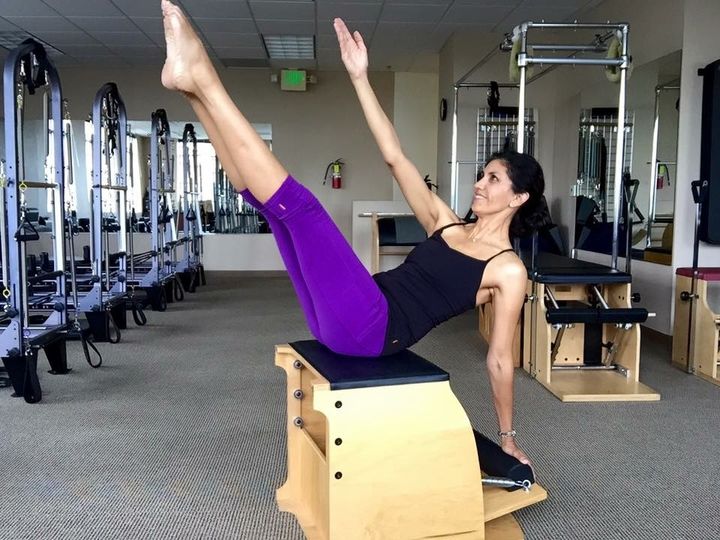
Pilates Teaser with a Side Arm Twist on the Wunda Chair
I read an article several months ago where a few celebrity trainers were spouting off about workouts that they hated. Pilates made the list with one trainer even claiming that most Pilates teachers wouldn’t be able to handle the monkey bars. Well, as a physical therapist and Pilates teacher, I’d wager that he’d probably have difficulty handling my resistance bands and 1 pound weights because I can pinpoint someone’s weak-spots pretty quickly, but that’s besides the point. My point is that Pilates, when executed properly, is a valuable form of training that compliments other training methods and might make the difference between someone progressing towards their fitness goals and someone ending up as a patient.
First and foremost, let me clear up 3 common misconceptions about Pilates.
1. The CORE is not just your 6-pack abs, and Pilates is not just about strengthening it. Let’s first start by saying that most people have a misunderstanding about what the core actually is. The core is not just the 6-pack. The core is not something Pilates teachers are trying to “strengthen” in isolation. The core is a symphony between the deepest abdominal muscles, pelvic floor, diaphragm, and the tiny, deep stabilizing muscles of the spine. These are muscles that are designed to anticipate the load that the spine will have placed on it rather than what the larger muscle groups (the 6 pack muscles, etc) that are more responsible for consciously “muscling out the movement.”
A well-designed Pilates session uses language and gentle tactile cues that focuses on alignment. When the skeleton is aligned, then those core muscles have a chance at control…without artificially needing to say “squeeze”, “tuck,” or “tighten.” The core is about control. Pilates emphasizes control before moving on to more challenging feats of strength.
2. While Pilates improves flexibility, it’s not just about stretching. I always have to resist doing the internal eye roll when people find out that I am a PT/Pilates teacher and they ask, “Can you give me a stretch for my tight hamstrings/neck/back?”
So here’s the thing…rather than trying to lengthen the muscle that seems tense and shortened, we need to look at WHY that muscle is in that state in the first place. It may surprise you that muscles often get tense because those deep core stabilizers I mentioned in #1 are not doing their job. When those small stabilizers are no longer able to activate at the appropriate time or handle the postural asymmetry that our daily life has provided, our larger muscles try to do the job. The problem is, those larger muscles aren’t made for posture…meaning, they’re not designed to be “on” all day long. Rather, they’re designed for creating movement and to have the ability to turn on and off when needed.
If you try to stretch a tight muscle group with long holds, it may feel good at the time, but the results will be temporary because the brain/body doesn’t know what to do with that new motion. By contrast, when you lengthen the muscle while concurrently using the core stabilizers to help align the body and control the movement, THEN you’re on to something. By the way…Pilates does this. That’s why we don’t just go into a position and hold a stretch, but rather, we encourage controlled movement. This control is ultimately what allows for the sensation of flexibility.
3. Just because doing Pilates alone isn’t going to “melt away your belly fat,” doesn’t mean it’s useless. While you can get a pretty intense workout doing Pilates, most Pilates sessions are not cardiovascular in nature and definitely not at the level of intensity that will make a huge dent in your fat loss journey if that is your primary goal. Losing weight is systemic, not something you can “spot reduce”. It requires a combination of proper diet and caloric burn and is influenced by other factors such as stress, hormones, and genetics to name a few.
However, just because Pilates doesn’t have the intensity needed for dramatic weight loss, it can be an important part of the puzzle. Mastering movement quality, as is required in Pilates exercise, creates the foundation that allows you to do more intense exercise when speed and resistance are added. There are ways to incorporate high intensity interval training (HIIT) in a Pilates class (CLICK HERE FOR RELATED VIDEO). In addition, the mindfulness component within a Pilates session can be great for reducing stress and bringing focus to what’s happening to your body. This can be an important mindset shift to get you on the right track.
With these three misconceptions clarified, I need to add that not all Pilates is the same in style and quality, and finding the right teacher for your body is just as important. Just as in any area of fitness, there is a spectrum of quality that will impact the results. Assuming you have a teacher who has had comprehensive training (look for those who are certified through the Pilates Method Alliance or have completed a Pilates Teacher Training program with over 450 hours of focused training) and is attentive to what your body needs, you’ll find that Pilates’ benefits extend way beyond the goal of those 6 pack abs.
Ada Wells, DPT, PMA®-CPT is a Physical Therapist and Educator for Polestar Pilates International as well as the founder of www.ProBalance.TV, a site dedicated to showing people how use intelligent and mindful movement to stay active for the long haul.
